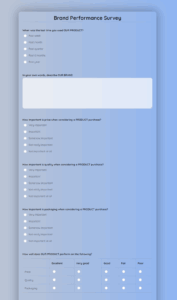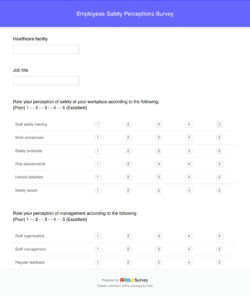In the complex world of food production and service, ensuring food safety isn’t just about following rules; it’s deeply rooted in the collective attitudes and behaviors of everyone involved. A strong food safety culture means that safety is a shared priority, embedded in daily operations, and championed from the top floor to the production line. But how do you truly know if your organization possesses such a culture, or if there are hidden gaps that could pose risks?
This is where a well-designed food safety culture survey template becomes an invaluable tool. It allows you to systematically gather feedback from your team, uncover perceptions, identify strengths, and pinpoint areas needing improvement, all of which are crucial steps towards building an even more robust and resilient food safety management system.
Why a Food Safety Culture Survey is Essential for Your Business
Moving beyond simple compliance audits, understanding your organization’s food safety culture offers a profound insight into your operational realities. Regulations and procedures are vital, but their effectiveness ultimately depends on how they are perceived and enacted by employees. A survey helps bridge the gap between written policy and daily practice, revealing if your team truly buys into the importance of food safety, or if it’s merely seen as a checklist item.
Implementing a food safety culture survey goes far beyond just ticking a box. It provides a direct channel for employees, who are often on the front lines, to voice their observations and concerns without fear. This valuable feedback can uncover subtle issues that might otherwise go unnoticed by management, such as communication breakdowns, inadequate training perceptions, or resource constraints that impact safe practices. It’s about tapping into the collective intelligence of your workforce.
Furthermore, a comprehensive survey acts as an early warning system. By regularly assessing the pulse of your food safety culture, you can proactively address potential weaknesses before they escalate into incidents or recalls. This forward-thinking approach not only protects consumers but also safeguards your brand reputation, prevents costly operational disruptions, and fosters a more secure and responsible working environment for everyone.
Ultimately, a robust food safety culture translates directly into fewer errors, higher product quality, and enhanced consumer trust. It demonstrates a commitment that extends beyond legal requirements, showing a genuine dedication to excellence. Therefore, having a structured approach, like using a meticulously crafted food safety culture survey template, is not just beneficial; it’s a strategic imperative for any food-related business aiming for long-term success and integrity.
Key Elements to Include in Your Food Safety Culture Survey Template
When developing or adapting a food safety culture survey template, it’s crucial to cover a broad spectrum of cultural indicators. The goal isn’t just to ask if people “feel safe” but to delve into the underlying behaviors, attitudes, and systems that contribute to or detract from safety. An effective template will typically categorize questions to provide a holistic view.
- Leadership Commitment: Questions should assess whether employees believe management prioritizes food safety, provides necessary resources, and acts on feedback. Do leaders “walk the talk”?
- Communication and Transparency: Evaluate how well food safety information is communicated throughout the organization. Are employees aware of policies? Do they feel comfortable reporting issues without fear of reprisal?
- Employee Engagement and Empowerment: Gauge if employees feel responsible for food safety, if they are encouraged to take initiative, and if their input is valued. Do they feel empowered to stop a process if they see a hazard?
- Risk Perception and Awareness: Understand how well employees identify and understand food safety risks relevant to their roles. Are they aware of the consequences of non-compliance?
- Resources and Training: Assess whether employees feel they have adequate training, tools, and time to perform their tasks safely. Is training effective and regularly updated?
- Continuous Improvement: Determine if there’s a perception that food safety processes are regularly reviewed and improved upon, and if lessons are learned from incidents or near misses.
By structuring your food safety culture survey template with these categories in mind, you ensure that you capture actionable data across all critical dimensions. This comprehensive approach provides a clear roadmap for targeted interventions and continuous improvement, ensuring your food safety culture evolves dynamically.
Implementing and Acting on Your Food Safety Culture Survey Results
Once you have a solid food safety culture survey template in hand and have gathered responses, the real work begins: implementation and action. The value of any survey lies not just in collecting data, but in how that data is analyzed, understood, and subsequently used to drive meaningful change within your organization. Ensuring anonymity is paramount during the collection phase to encourage honest and unbiased feedback.
After the data is collected, a thorough analysis is essential. Look for trends, outliers, and significant differences across departments or shifts. Are there specific areas where perceptions of food safety are weaker? Do certain employee groups feel less empowered or informed? Visualizing this data can help identify critical areas for improvement. Share the aggregated results transparently with employees, demonstrating that their input is valued and taken seriously.
The survey results should serve as a foundation for developing concrete action plans. For each identified weakness, brainstorm specific, measurable, achievable, relevant, and time-bound (SMART) objectives. This might involve revising training programs, improving communication channels, allocating more resources, or providing clearer guidance on reporting procedures. Involve employees in the solution-finding process; their insights are invaluable for creating effective and sustainable changes.
Remember that improving food safety culture is an ongoing journey, not a one-time event. The initial survey is a snapshot, a baseline. Subsequent surveys, conducted perhaps annually or bi-annually, will allow you to measure progress, identify new challenges, and ensure that your food safety culture continues to strengthen and adapt. This continuous feedback loop is vital for maintaining high standards and fostering a truly proactive food safety environment.
- Communicate findings transparently, showing respect for employee input.
- Develop targeted action plans based on specific survey insights.
- Involve employees directly in designing and implementing solutions.
- Monitor the effectiveness of changes and re-survey regularly to track progress.
A thriving food safety culture is the bedrock of any successful food business, going beyond mere compliance to embed safety deep within the organizational DNA. Utilizing a thoughtful food safety culture survey template provides the necessary framework to assess, understand, and strategically enhance this critical aspect of your operations, turning potential vulnerabilities into areas of strength and distinction.
By consistently measuring perceptions, acting on feedback, and fostering an environment where every employee feels accountable and empowered, you not only elevate your food safety standards but also cultivate a more resilient, reputable, and ultimately, more successful enterprise. It’s an investment in your people, your product, and your promise to consumers.


